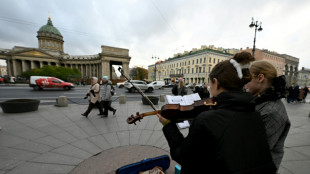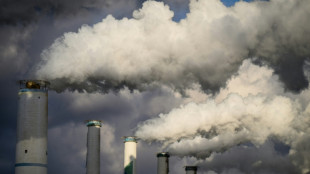
-
 Trump hosts Saudi prince for first time since Khashoggi killing
Trump hosts Saudi prince for first time since Khashoggi killing
-
Tonga's Katoa out of NRL season after brain surgery

-
 Japan warns citizens in China over safety amid Taiwan row
Japan warns citizens in China over safety amid Taiwan row
-
In Somalia, a shaky front line barely holds back the 'dogs of war'

-
 Shares in 'Baby Shark' studio jump on market debut
Shares in 'Baby Shark' studio jump on market debut
-
Thunder breeze past Pelicans, Pistons overpower Pacers

-
 Grieving Cowboys remember Kneeland, defeat Raiders
Grieving Cowboys remember Kneeland, defeat Raiders
-
Loaf behind bars: Aussie inmate says Vegemite a human right

-
 In film's second act, 'Wicked' goes beyond Broadway musical
In film's second act, 'Wicked' goes beyond Broadway musical
-
Asian markets track Wall St down with Nvidia, US jobs in view

-
 Scott Boland: the best 'spare' fast bowler around
Scott Boland: the best 'spare' fast bowler around
-
Fire and Ashes: England bank on fast bowling barrage in Australia

-
 North Korea says Seoul-US sub deal will trigger 'nuclear domino' effect
North Korea says Seoul-US sub deal will trigger 'nuclear domino' effect
-
Education for girls hit hard by India's drying wells

-
 Haitian gangs getting rich off murky market for baby eels
Haitian gangs getting rich off murky market for baby eels
-
Trump says will talk to Venezuela's Maduro, 'OK' with US strikes on Mexico

-
 Oscar Piastri wins Australia's top sports honour
Oscar Piastri wins Australia's top sports honour
-
'Severely restricted': Russia's Saint Petersburg faces cultural crackdown

-
 Polish PM denounces 'sabotage' of railway supply line to Ukraine
Polish PM denounces 'sabotage' of railway supply line to Ukraine
-
UK toughens asylum system with radical overhaul

-
 Carney's Liberals pass budget, avoiding snap Canada election
Carney's Liberals pass budget, avoiding snap Canada election
-
LeBron back in training, edges closer to Lakers return

-
 Climate talks run into night as COP30 hosts seek breakthrough
Climate talks run into night as COP30 hosts seek breakthrough
-
Germany and Netherlands lock up World Cup spots in style

-
 Germany's Woltemade hopes for 2026 World Cup spot after scoring again
Germany's Woltemade hopes for 2026 World Cup spot after scoring again
-
Germany 'send message' with Slovakia rout to reach 2026 World Cup

-
 Trump unveils fast-track visas for World Cup ticket holders
Trump unveils fast-track visas for World Cup ticket holders
-
Netherlands qualify for World Cup, Poland in play-offs

-
 Germany crush Slovakia to qualify for 2026 World Cup
Germany crush Slovakia to qualify for 2026 World Cup
-
Stocks gloomy on earnings and tech jitters, US rate worries

-
 'In it to win it': Australia doubles down on climate hosting bid
'In it to win it': Australia doubles down on climate hosting bid
-
Former NFL star Brown could face 30 yrs jail for shooting case: prosecutor

-
 Fate of Canada government hinges on tight budget vote
Fate of Canada government hinges on tight budget vote
-
New research measures how much plastic is lethal for marine life

-
 Mbappe, PSG face off in multi-million lawsuit
Mbappe, PSG face off in multi-million lawsuit
-
EU defends carbon tax as ministers take over COP30 negotiations

-
 McCartney to release silent AI protest song
McCartney to release silent AI protest song
-
Stocks tepid on uncertainty over earnings, tech rally, US rates

-
 Louvre shuts gallery over ceiling safety fears
Louvre shuts gallery over ceiling safety fears
-
'Stranded, stressed' giraffes in Kenya relocated as habitats encroached

-
 US Supreme Court to hear migrant asylum claim case
US Supreme Court to hear migrant asylum claim case
-
Western aid cuts could cause 22.6 million deaths, researchers say

-
 Clarke hails Scotland 'legends' ahead of crunch World Cup qualifier
Clarke hails Scotland 'legends' ahead of crunch World Cup qualifier
-
S.Africa says 'suspicious' flights from Israel show 'agenda to cleanse Palestinians'

-
 South Korea pledges to phase out coal plants at COP30
South Korea pledges to phase out coal plants at COP30
-
Ex-PSG footballer Hamraoui claims 3.5m euros damages against club

-
 Mbappe, PSG in counterclaims worth hundreds of millions
Mbappe, PSG in counterclaims worth hundreds of millions
-
Two newly discovered Bach organ works unveiled in Germany

-
 Stocks lower on uncertainty over earnings, tech rally, US rates
Stocks lower on uncertainty over earnings, tech rally, US rates
-
Barca to make long-awaited Camp Nou return on November 22


Brightest flash ever disturbed Earth's atmosphere last year
Last year the brightest flash of light ever seen in the night sky disturbed Earth's upper atmosphere in a way that has never before detected before, researchers said on Tuesday.
A massive burst of gamma rays from an enormous cosmic explosion around two billion light years away arrived at Earth on October 9, 2022, lighting up telescopes around the world.
Quickly nicknamed the "BOAT" -- for Brightest Of All Time -- the flash lasted just seven minutes but its afterglow was visible to amateur astronomers for seven hours.
The flash activated lightning detectors in India and triggered instruments that normally study explosions on the Sun called solar flares.
It also affected long wave radio communications in the lower ionosphere, a section of Earth's upper atmosphere around 60 to 350 kilometres (37 to 217 miles) above the surface.
The BOAT also affected the upper ionosphere -- the very first time a gamma-ray burst has been observed in this section of the atmosphere, a team of Italian and Chinese researchers said on Tuesday.
From 350 to 950 kilometres above Earth, near the edge of the space, the upper ionosphere is where radiation from the Sun turns into charged particles that form an important electric field.
Mirko Piersanti, a researcher at Italy's University of L'Aquila, told AFP that experts in this field had been debating for two decades whether gamma ray bursts could have any impact on the upper ionosphere.
"I think we finally answered the question," said Piersanti, the lead author of a new study in the journal Nature Communications.
The researchers were lucky that the Chinese–Italian CSES satellite, which has an electric field detector, "was exactly in the zone that was illuminated by the gamma-ray burst" 500 kilometres above Earth in the upper ionosphere, he said.
"We found a shape in the electric field that had never been observed before," Piersanti added.
"It is amazing," European Space Agency gamma-ray expert Erik Kuulkers said in a statement.
"We can see things that are happening in deep space but are also affecting Earth."
- Extinction threat? -
Piersanti said the research would help scientists understand the potential threat that other gamma-ray bursts could pose in the future.
The worst-case scenario would be if such a powerful blast came from much closer to home -- say, within our own Milky Way galaxy. That could "completely erase" Earth's ozone layer, he said.
This would expose everything on the surface to the full might of the Sun's ultraviolet radiation, potentially wiping out life on Earth.
There has previously been speculation that past gamma-ray bursts could have caused ancient mass extinction events.
But Piersanti emphasised that much remains unknown.
It is also possible that the ionosphere would absorb all the gamma rays and "nothing would happen" to those of us on the ground, he explained.
Last year's gamma-ray burst, officially called GRB 221009A, is believed to have been caused by either a massive dying star exploding into a supernova, or the birth of a black hole.
Given its immense power, it could also have been both -- a supernova explosion leading to the creation of a black hole.
The blast came from the direction of the constellation Sagitta and travelled an estimated 1.9 billion years to reach Earth.
It is now 2.4 billion light years away because of the expansion of the universe.
On average, more than one gamma-ray-burst reaches Earth every day.
But one with the brightness of the BOAT is estimated to come around once every 10,000 years.
Q.Jaber--SF-PST




